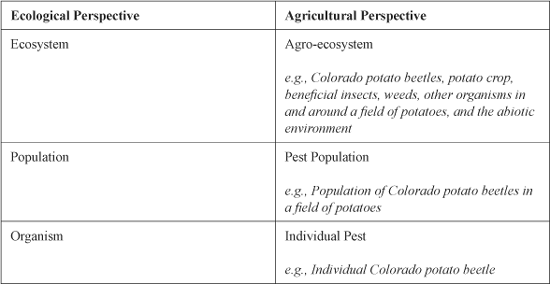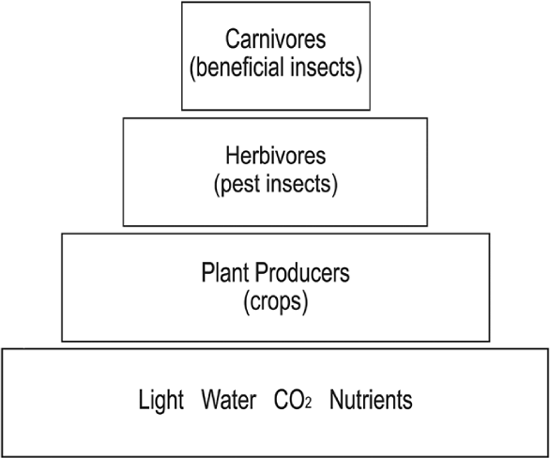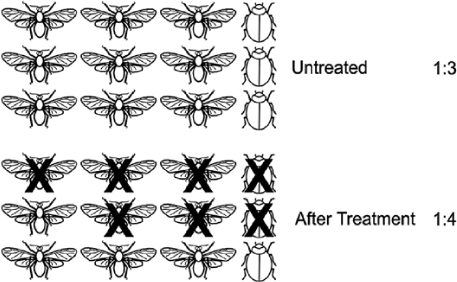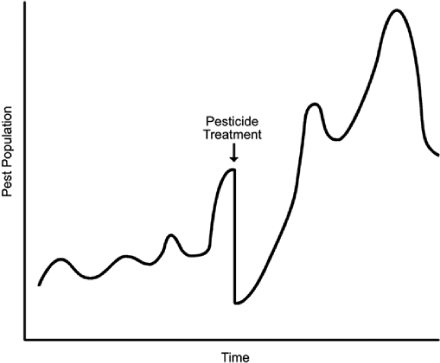Ecological Science
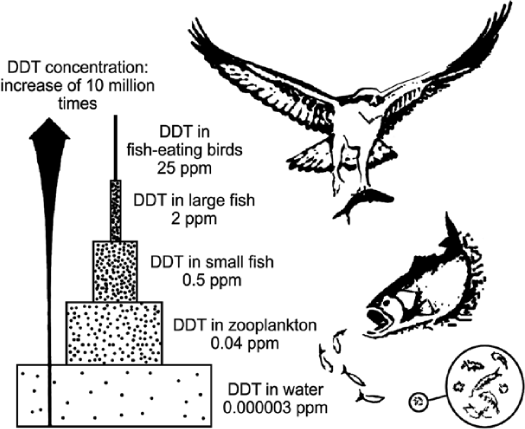
Chapter 1
Ecological Science
Basic Ecological Concepts
Fly over almost any farm field today and you will see endless rows of crops aligned in giant monocultures, likes stripes on the landscape. Walk into that farm field and look more closely and you are likely to encounter many more living organisms: insects feeding on crops, weeds growing between crop rows, nematodes and other organisms living in the soils. Look even more closely, and you will see the multifaceted mosaic of living organisms with intricate relationships among them. Birds and predatory insects may be feeding on pest insects, parasitic and parasitoid insects may be laying their eggs in the bodies of pest caterpillars where their larvae may literally eat the caterpillars from the inside out, and a host of other species with complex interactions between the species and their environments may be present. In other words, the agricultural field, even the field that appears to be a mere monoculture, is a living ecosystem, governed by the principles of ecology. Humans trying to improve crop yields by reducing pest damage impact the agricultural ecosystem, as well as the surrounding natural or human-managed ecosystems, in an almost indefinite number of ways depending on the type of system, the pest management chemical or approach used, and a number of other factors. Pest management through chemical or other pest management approaches not only impacts the population of the pest species themselves, but also impacts populations of non-target species and disrupts complex interactions among the entire community of species and their abiotic environment.
An agricultural field, although managed by humans and often consisting of large-scale monoculture, is not a sterile laboratory. It is a complex assemblage of living organisms with relationships to each other and the abiotic community in which they exist. Accordingly, to understand the effects of pesticides and other pest management in an agricultural system, it is first necessary to have a basic understanding of ecology and ecological systems. Ecological principles apply to all living organisms, whether those organisms exist in a pristine natural environment or whether they exist as pests or beneficial organisms in a human-managed agricultural environment.1
To understand the role of ecology in environmental law addressing pesticide-related issues, it is necessary to have a basic understanding of some fundamental ecological concepts and how they relate to pests, pest management, and pesticides. This chapter provides an overview of well-established ecological concepts that come into play in discussions and analysis in other portions of the book. Because this chapter is primarily descriptive of basic concepts that have appeared extensively in published works by ecology scholars, it draws heavily from a few such works, most significantly, Robert Norris, Edward Caswell-Chen and Marcos Kogan’s 2003 book entitled Concepts in Integrated Pest Management,2 and two other books in the Ecology and Law in Modern Society series.3
A good starting point for an attempt to understand the complexity, uncertainty, and changing nature of natural systems is an understanding of the numerous fields of inquiry and terminology used to describe these systems. “Ecology” is the science of the interactions of living organisms with each other and their biotic and abiotic environment.4 The term “ecology” has been described in more detail as follows:
Ecology is the study of the relationship of organisms and their environment. The environment includes other individuals in its population, other populations of plants and animals with which an organism and its population interacts, and the physical and chemical factors that influence life (i.e., the abiotic environment). ‘Relationships’ include such diverse subjects as the adaptation of an individual’s physiology to environmental extremes (e.g., low moisture and high temperatures), the killing and eating of prey by predators, and the flow of carbon through the living and non-living components of the environment. To study such a diversity of natural phenomena, ecology takes an interdisciplinary approach, drawing from biology, chemistry, physics, and the earth sciences to achieve an understanding of how the natural world functions, and in so doing, sustains human life.5
In the first book in this series, Brooks et al., outline the evolution of ecology as a scientific discipline starting in the latter half of the nineteenth century. As Brooks et al. explain, by the 1920s, ecology “had become the detailed, empirical study of dynamic systems of interactions between the living components and environmental factors making up a local community.”6 The field of ecosystems ecology developed later and was the subdiscipline of ecology that played an influential role in the development of the major federal environmental laws that grew out of the environmental movement of the 1960s and 1970s.7
Ecosystem Organization
One of the organizing principles of ecology is levels of ecosystem organization. Norris et al. present the levels of organizations within the context of pest management as follows:
Individual : a single organism such as a bacterium, a weed, a nematode, or a lygus bug.
Population : all individuals of a species within a defined area usually isolated to some degree from other similar groups, such as weeds or boll weevils on an acre of cotton field.
Community : the assemblage of all species occurring together within a limited geographic area. Within an agricultural field, the community would include the crop plants, weeds, pathogens, bacteria, fungi, nematodes, insects, and vertebrates.
Ecosystem : a community of organisms together with the abiotic environment in a specified region …. In the pest management context, ecosystems can be thought of as the crop fields and the surrounding ditches, hedges, woodlands, and so forth, within a defined area such as a valley or a watershed. Agricultural ecosystems are termed agro-ecosystems.8
An important concept with significance to pest management is “succession,” which is “the chronological sequence of successive species in a biotic community ….”9 The classic example of succession is the sequence of life that arises after a forest fire: first the quick-growing weedy species move in, followed by shrubs, and finally by slow-growing trees. Succession is significant in agriculture and pest management because, as Norris et al. point out, “[a]griculture represents human attempts to arrest succession … so that the net increase in biomass (energy) can be harvested for human benefit. Arresting succession requires human inputs to the system, and the greater the input, the earlier in the successional stage the system can be arrested and the greater the return that humans can harvest.”10 In particular, pest management disrupts succession by attempting to eliminate weeds, the primary stage of succession.11
Figure 1.1 Ecosystem organization from ecological and agricultural perspectives
Another ecological concept important in pest management is that of trophic dynamics. Trophic relationships in an ecosystem are often referred to in common parlance as the “food chain.” A simplistic view of trophic dynamics is a linear “bottom-up” system of energy flow coupled with a top-down system of consumption of organisms. As illustrated in Figure 1.2, at the bottom of the food chain are the inputs of energy via sunlight, water, CO2 and nutrients. The next level up, or the next “trophic level”, consists of plant producers who use these inputs to photosynthesize and make plant biomass.12 At each level some energy is lost and generally there are higher numbers of smaller individuals at the lower levels, and lower numbers of larger individuals at the higher trophic levels.13 The next trophic layer up consists of the herbivore primary consumers who feed on the plant producer, followed by a top trophic level of primary carnivores, or secondary consumers, who feed on the herbivore below.14
In an example of trophic levels in a farm field, the crop plant would be the producer, an insect pest of the plant would be the herbivore/primary consumer, and a predatory insect that consumes the pest insect would be the primary carnivore or secondary consumer.
Figure 1.2 Diagram of simple agricultural food chain trophic levels
The organisms at the higher trophic levels consume organisms at lower levels, thereby controlling the population of the organisms in the lower levels. If high-trophic-level organisms, such as species that prey on pest insects, are removed from the system, populations of organisms at the next trophic level down, in this example, the pest insects, will increase. An increase in pest population will in turn result in more crop damage.15 Thus, from a pest management standpoint, high-trophic-level predators and parasites are extremely important in managing population levels of lower trophic-level pests and therefore keeping crop damage to a minimum.16 As will be discussed in more detail in later chapters, one significant negative side effect of using chemical pesticides that kill a wide range of organisms (or broad-spectrum pesticides), is that they kill not only the target pest, but also the higher trophic-level carnivores and parasites, thereby potentially resulting in increased pest populations. Figure 1.3 illustrates how predator–pest ratios can be altered by pesticide use.
Figure 1.3 Predator–pest ratios after pesticide treatment
When pesticide use kills the predators and parasites that naturally keep pest populations in check, there is often a resurgence of pest populations. As illustrated in Figure 1.4 (below), such resurgence frequently results in a greater pest problem than existed prior to the pesticide treatment.
Figure 1.4 Pest resurgence following pesticide treatment that kills the beneficial predators and parasites that previously kept the pest population under control
Another significant concept involving trophic levels and pesticides, illustrated in Figure 1.5, is that of bioaccumulation, wherein certain types of pesticides found in low concentrations in the bodies of organisms at low trophic levels will accumulate increasingly as organisms in each higher trophic level feed on organisms at the next level down, until the bodies of the highest trophic level predators or parasites contain dramatically greater concentrations of the pesticide.17
